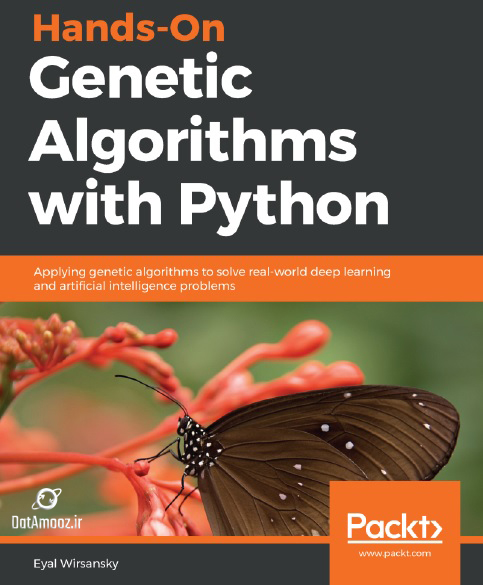الگوریتم های ژنتیک با الهام از نظریه تکامل طبیعی چارلز داروین، از جذاب ترین تکنیک ها برای حل مشکلات جستجو، بهینه سازی و یادگیری هستند و در مواردی که الگوریتم های سنتی نتوانند نتایج کافی را در یک بازه زمانی معقول ارائه دهند، می توانند موفقیت آمیز باشند.
این کتاب شما را به سفری رهنمون می کند تا به این روش بسیار قدرتمند و در عین حال ساده، با استفاده از آن در طیف گسترده ای از توابع، که در اوج کاربردهای AI است، تسلط پیدا کنید.
با استفاده از این کتاب، شما درک درستی از الگوریتم های ژنتیک، نحوه کار آنها و زمان استفاده از آنها خواهید داشت. علاوه بر این، این کتاب تجربه عملی استفاده از الگوریتم های ژنتیک در حوزه های مختلف با استفاده از زبان برنامه نویسی معروف Python را برای شما فراهم می کند.
این کتاب برای چه کسانی است؟
این کتاب برای کمک به توسعه دهندگان نرم افزار، دانشمندان علوم داده و علاقه مندان به هوش مصنوعی که می خواهند با استفاده از الگوریتم های ژنتیک برای انجام کارهایی همچون یادگیری، جستجو و بهینه سازی در برنامه های خود و همچنین افزایش عملکرد و دقت در برنامه های هوشمند داشته باشند، نوشته شده است.
این کتاب همچنین برای هرکسی که می خواهد در دنیای حقیقی مشکلاتی را حل کند که الگوریتم های سنتی مفید نیستند یا نمی توانند در مدت زمان خوبی نتایج کافی را ارائه دهند، مفید است.
این کتاب نشان می دهد که چگونه می توان از الگوریتم های ژنتیک به عنوان یک رویکرد قدرتمند، در عین حال ساده ، برای حل انواع مشکلات پیچیده استفاده کرد.
عنوان کتاب: Hands-On Genetic Algorithms with Python
زبان آموزش : انگلیسی
تعداد صفحه: 334 ص
نویسنده: Eyal Wirsansky
حجم فایل: 8.98 مگابایت
 برای دریافت فایل اینجا را کلیک کنید(لینک مستقیم)
برای دریافت فایل اینجا را کلیک کنید(لینک مستقیم)
سرفصل های کتاب:
Section 1: The Basics of Genetic Algorithms
-
Chapter 1: An Introduction to Genetic Algorithms
- What are genetic algorithms?
- The theory behind genetic algorithms
- Differences from traditional algorithms
- Advantages of genetic algorithms
- Limitations of genetic algorithms
- Use cases of genetic algorithms
- Summary
- Further reading
-
Chapter 2: Understanding the Key Components of Genetic Algorithms
- Basic flow of a genetic algorithm
- Selection methods
- Crossover methods
- Mutation methods
- Real-coded genetic algorithms
- Understanding elitism
- Niching and sharing
- The art of solving problems using genetic algorithms
- Summary
- Further reading
Section 2: Solving Problems with Genetic Algorithms
-
Chapter 3: Using the DEAP Framework
- Technical requirements
- Introduction to DEAP
- Using the creator module
- Using the Toolbox class
- The OneMax problem
- Solving the OneMax problem with DEAP
- Using built-in algorithms
- Experimenting with the algorithm's settings
- Summary
- Further reading
-
Chapter 4: Combinatorial Optimization
- Technical requirements
- Search problems and combinatorial optimization
- Solving the knapsack problem
- Solving the TSP
- Solving the VRP
- Summary
- Further reading
-
Chapter 5: Constraint Satisfaction
- Technical requirements
- Constraint satisfaction in search problems
- Solving the N-Queens problem
- Solving the nurse scheduling problem
- Solving the graph coloring problem
- Summary
- Further reading
-
Chapter 6: Optimizing Continuous Functions
- Technical requirements
- Chromosomes and genetic operators for real numbers
- Using DEAP with continuous functions
- Optimizing the Eggholder function
- Optimizing Himmelblau's function
- Simionescu's function and constrained optimization
- Summary
- Further reading
Section 3: Artificial Intelligence Applications of Genetic Algorithms
- Chapter 7: Enhancing Machine Learning Models Using Feature Selection
- Technical requirements
- Supervised machine learning
- Feature selection in supervised learning
- Selecting the features for the Friedman-1 regression problem
- Selecting the features for the classification Zoo dataset
- Summary
- Further reading
-
Chapter 8: Hyperparameter Tuning of Machine Learning Models
- Technical requirements
- Hyperparameters in machine learning
- Tuning the hyperparameters using a genetic grid search
- Tuning the hyperparameters using a direct genetic approach
- Summary
- Further reading
-
Chapter 9: Architecture Optimization of Deep Learning Networks
- Technical requirements
- Artificial neural networks and deep learning
- Optimizing the architecture of a deep learning classifier
- Combining architecture optimization with hyperparameter tuning
- Summary
- Further reading
-
Chapter 10: Reinforcement Learning with Genetic Algorithms
- Technical requirements
- Reinforcement learning
- OpenAI Gym
- Solving the MountainCar environment
- Solving the CartPole environment
- Summary
- Further reading
Section 4: Related Technologies
-
Chapter 11: Genetic Image Reconstruction
- Technical requirements
- Reconstructing images with polygons
- Image processing in Python
- Using genetic algorithms to reconstruct images
- Summary
- Further reading
-
Chapter 12: Other Evolutionary and Bio-Inspired Computation Techniques
- Technical requirements
- Evolutionary computation and bio-inspired computing
- Genetic programming
- Particle swarm optimization
- Other related techniques
- Summary
- Further reading
- Other Books You May Enjoy

 برای دریافت فایل اینجا را کلیک کنید(لینک مستقیم)
برای دریافت فایل اینجا را کلیک کنید(لینک مستقیم)